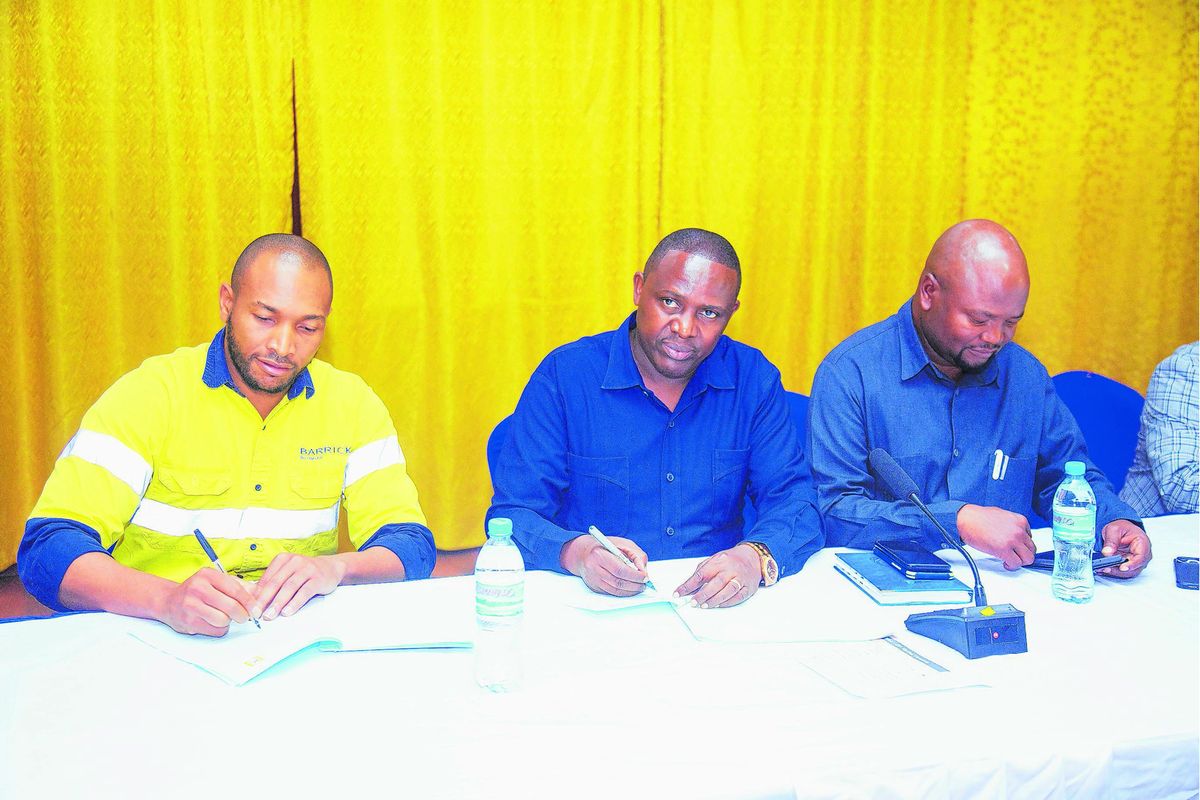
Tanzania, Kahama:
Finally, Barrick Bulyanhulu Gold Mine in Kahama district, Shinyanga region has signed a bargain agreement with its employees after long drawn negotiations.
The outcome will see hundreds of workers getting terminal benefits like other employees in the formal sector as well as funds to educate their children.
“The agreement will see significant improvement of the remunerations of the workers,” said Partenus Rwechungura, the Secretary General of Tanzania, Mines, Energy, Construction and Allied Workers’ Union (Tamico).
He said the bargain agreement has been signed after long discussions between the management of one of the largest gold mines in the country and Tamico on behalf of hundreds of employees.
“Barrick employees (at Bulyanhulu) will now be entitled to terminal benefits and incentive funds for the education of their children,” he said.
The trade union leader added: “As a trade union, we are pleased to see the management of the mine realising the importance of this agreement.”
Improved remunerations will boost the morale of workers and improve work relations at the mine located in Msalala Council in Kahama district.
Bulyanhulu Gold Mine General Manager, Cheick Sangare said now that their demands have been met with the signing of the agreement, the workers must now fulfil their responsibilities.
“We expect to see you double your efforts and creativity so that both the mine and the workers mutually benefit from the deal,” he pointed out.
Mr Sangare said the signing of the agreement by the mine management was enough indication that Bulyanhulu Gold Mine was operating within the confines of the law.
“It is also a sign that the management of the mine will implement terms of the agreement for mutual benefit of the parties involved,” he explained.
Kahama District Commissioner, Festo Kiswaga said improved workers’ remunerations would not only boost productivity but also increase tax collections.
He challenged the workers to work hard so that the mine can generate more gold from its pits and hence increase gold sales in the international markets.
Signing of the agreement was also witnessed by Assistant Labour Commissioner, Andrew Mwalwisi from the Prime Minister’s Office; Labour, Youth, Employment and the Disabled docket.
He took the opportunity to urge all employers in the country to pay the new wage rates, including the minimum wage as recently announced by the government.
He decried a tendency of some employers, both in private and public companies in the country, to ignore the legal requirement to pay the levels directed by the Government.
On his part, the chairman of the Bulyanhulu Mine Tamico branch, Maghembe Malimi, lauded the move by the two sides -mine management and workers – in signing of the bargain agreement.
Share this news
This Year’s Most Read News Stories

Kampuni ya Elon Musk kuzindua mtandao Tanzania
Huduma ya mtandao ya Elon Musk ya Starlink inatarajiwa kupatikana nchini Tanzania katika robo ya kwanza ya 2023, huku wachambuzi wakisema maendeleo hayo mapya yatakuza uchumi wa kidijitali.Continue Reading

Tanzania Confirms Second Marburg Outbreak After WHO Chief Visit
Dar es Salaam — Tanzania’s President Samia Suluhu Hassan has declared an outbreak of Marburg virus, confirming a single case in the northwestern region of Kagera after a meeting with WHO director-general Tedros Adhanom Ghebreyesus.
The confirmation follows days of speculation about a possible outbreak in the region, after the WHO reported a number of deaths suspected to be linked to the highly infectious disease.
While Tanzania’s Ministry of Health declared last week that all suspected cases had tested negative for Marburg, the WHO called for additional testing at international reference laboratories.
“We never know when an outbreak might occur in a neighbouring nation. So we ensure infection prevention control assessments at every point of care as routine as a morning greeting at our workplaces.”Amelia Clemence, public health researcher
Subsequent laboratory tests conducted at Kagera’s Kabaile Mobile Laboratory and confirmed in Dar es Salaam identified one positive case, while 25 other suspected cases tested negative, the president told a press conference in Dodoma, in the east of the country today (Monday).
“The epicentre has now shifted to Biharamulo district of Kagera,” she told the press conference, distinguishing this outbreak from the previous one centred in Bukoba district.
Tedros said the WHO would release US$3 million from its emergencies contingency fund to support efforts to contain the outbreak.
Health authorities stepped up surveillance and deployed emergency response teams after the WHO raised the alarm about nine suspected cases in the region, including eight deaths.
The suspected cases displayed symptoms consistent with Marburg infection, including headache, high fever, diarrhoea, and haemorrhagic complications, according to the WHO’s alert to member countries on 14 January. The organisation noted a case fatality rate of 89 per cent among the suspected cases.
“We appreciate the swift attention accorded by the WHO,” Hassan said.
She said her administration immediately investigated the WHO’s alert.
“The government took several measures, including the investigation of suspected individuals and the deployment of emergency response teams,” she added.
Cross-border transmission
The emergence of this case in a region that experienced Tanzania’s first-ever Marburg outbreak in March 2023 has raised concerns about cross-border transmission, particularly following Rwanda’s recent outbreak that infected 66 people and killed 15 before being declared over in December 2024.
The situation is particularly critical given Kagera’s position as a transport hub connecting four East African nations.
Amelia Clemence, a public health researcher working in the region, says constant vigilance is required.
“We never know when an outbreak might occur in a neighbouring nation. So we ensure infection prevention control assessments at every point of care as routine as a morning greeting at our workplaces.”
The Kagera region’s ecosystem, home to fruit bats that serve as natural reservoirs for the Marburg virus, adds another layer of complexity to disease surveillance efforts.
The virus, closely related to Ebola, spreads through contact with bodily fluids and can cause severe haemorrhagic fever.
Transparency urged
Elizabeth Sanga, shadow minister of health for Tanzania’s ACT Wazalendo opposition party, says greater transparency would help guide public health measures.

Sign up for free AllAfrica Newsletters
Get the latest in African news delivered straight to your inbox
“This could have helped to guide those who are traveling to the affected region to be more vigilant and prevent the risk of further spread,” she said.
WHO regional director for Africa Matshidiso Moeti says early notification of investigation outcomes is important.
“We stand ready to support the government in its efforts to investigate and ensure that measures are in place for an effective and rapid response,” she said, noting that existing national capacities built from previous health emergencies could be quickly mobilised.
The situation coincides with leadership changes in Tanzania’s Ministry of Health, with both the chief medical officer and permanent secretary being replaced.
This piece was produced by SciDev.Net’s Sub-Saharan Africa English desk.
Source: allafrica.com

Zanzibar airport monopoly puts 600 jobs at risk
On September 14, 2022, the director general of ZAA issued a directive that gave Dnata Zanzibar Aviation Services Limited an exclusive access to the newly constructed Terminal III, barring other operators.Continue Reading










